10 marvellous buildings in Budapest
In this article we would like to give you 10 stunning examples of state-of-the-art architectures in Budapest, most of which you can visit inside and outside as well. Former casino buildings, guesthouses, cafés will be included in our list with a little bit of background for you to read. Each building is in downtown Budapest, near well-known landmarks. In some cases, the buildings are the landmarks themselves in their vicinity. After discovering the city from the most advantageous point; from the Danube, taking a sightseeing cruise, we highly recommend seeking out these beauties and give them a visit. Almost all the listed architectures are visitable, and you can catch a glimpse of the interior of these marvels 24/7. So, do not hesitate to explore more and discover the obvious, yet still hidden architectural gems of Budapest.
1. Budapest University of Technology and Economics Main Building
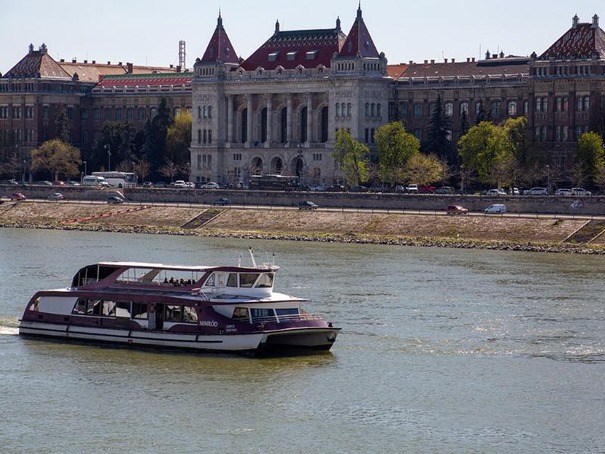
Photo: Silverline Cruises
Designed by renowned Hungarian architect Frigyes Schulek in the late 19th century, this grand Neo-Renaissance building serves as the main campus of the Budapest University of Technology and Economics. Its impressive facade is adorned with statues, reliefs, and intricate detailing, making it a prominent landmark in the city. Founded in 1782, it is one of the oldest technical universities in the world and has played a significant role in shaping Hungary’s scientific and technological landscape.
Located in the heart of Budapest, the university’s main campus features a blend of historic and modern buildings, reflecting its rich academic tradition and innovative approach to education and research. With a wide range of undergraduate, graduate, and doctoral programs offered across various disciplines, including engineering, economics, architecture, and natural sciences, BME attracts students from diverse backgrounds and nationalities.
BME is renowned for its rigorous academic standards, cutting-edge research initiatives, and close ties with industry partners, providing students with valuable hands-on experience and opportunities for professional development. The university’s vibrant campus life, cultural events, and extracurricular activities contribute to a dynamic and inclusive learning environment, fostering creativity, collaboration, and excellence.
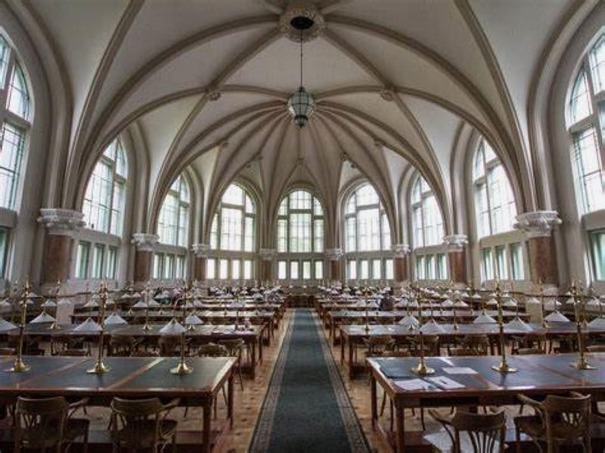
Photo: WeLoveBudapest – BME interior, library
2. Vajdahunyad Castle
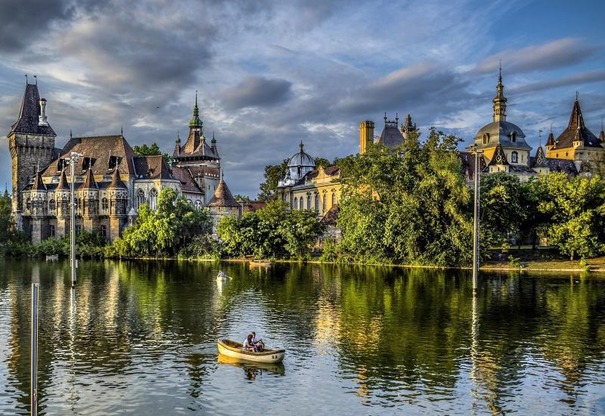
Photo: Wallpapers13.com – Great view of the Vajda Hunyad Castle from the City Park Lake
Situated in City Park (Városliget), Vajdahunyad Castle is a stunning architectural ensemble that showcases various styles from Hungarian history. The castle’s main building is a replica of the original Vajdahunyad Castle in Transylvania, while other sections represent different architectural periods, including Romanesque, Gothic, Renaissance, and Baroque. Originally built in 1896 as a temporary exhibition pavilion for the Millennium Exhibition, the castle’s design was inspired by various historical architectural styles from different regions of Hungary.
This enchanting castle complex features elements borrowed from iconic Hungarian landmarks, including the Hunyadi Castle in Transylvania, which served as a major source of inspiration. As a result, visitors can marvel at the Gothic, Renaissance, and Baroque architectural motifs that adorn its facades, towers, and courtyards.
Today, Vajdahunyad Castle serves as a cultural hub and museum, housing the Museum of Hungarian Agriculture and various exhibitions dedicated to Hungarian history and culture. Its picturesque surroundings, including a tranquil lake and lush greenery, make it a popular destination for locals and tourists alike, offering a peaceful retreat from the bustling city life.
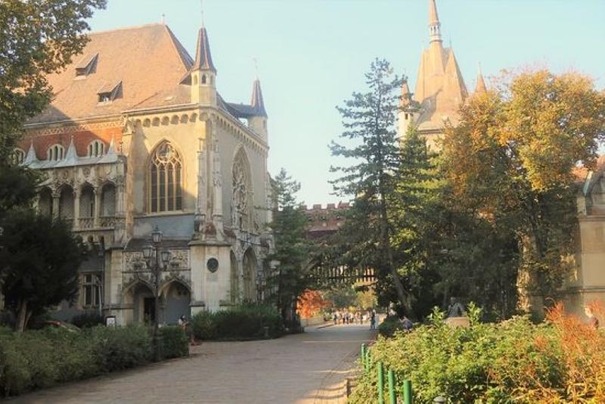
Photo: tripadvisor.com – Vajda Hunyad Castle inside
3. New York Café – Hotel Boscolo
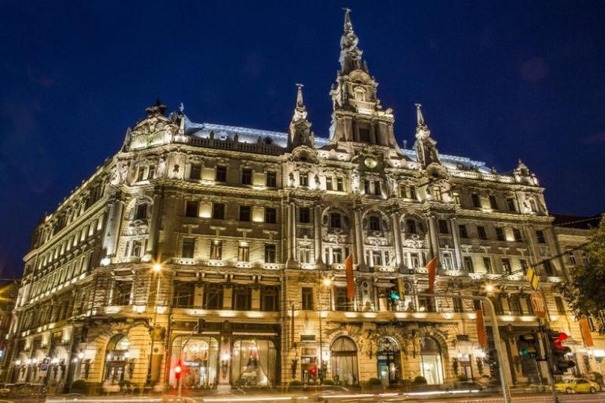
Photo: theluxevoyager.com
The New York Café, located within the grand Hotel Boscolo, is often referred to as the “most beautiful café in the world.” Stepping into this opulent establishment is like stepping back in time to the golden age of Budapest’s café culture. The café’s lavishly decorated interior features exquisite frescoes, glittering chandeliers, and marble columns, creating an atmosphere of unparalleled luxury. Visitors can indulge in decadent pastries and coffees while soaking in the grandeur of this historic venue, which has hosted many notable figures throughout its illustrious history.
Originally opened in the late 19th century as part of the New York Life Insurance Company’s Budapest headquarters, the café quickly became a beloved gathering place for writers, artists, and intellectuals. With its opulent decor, ornate chandeliers, marble columns, and intricate frescoes adorning the ceilings, the café exudes an atmosphere of timeless elegance and sophistication. Throughout its storied history, the New York Café has played host to countless luminaries, including writers like Ferenc Molnár and poets like Endre Ady, who frequented its halls, drawing inspiration from its vibrant ambiance and lively atmosphere.
Today, the New York Café continues to enchant visitors with its unparalleled beauty and charm. Guests can indulge in an array of gourmet pastries, coffees, and cocktails while immersing themselves in the café’s rich history and indulging in the timeless allure of Budapest’s café culture.
Be careful, there is usually a huge line. So, entering this wonderful building might take some time.
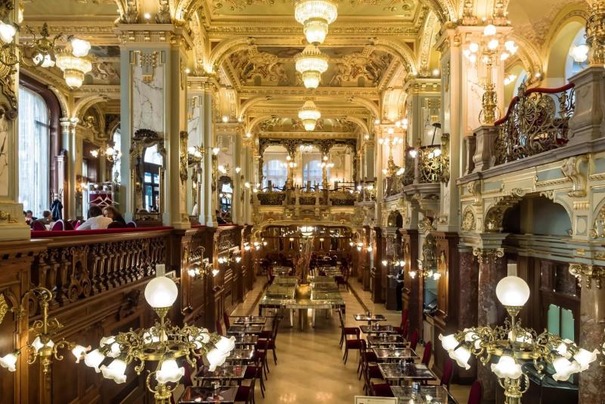
Photo: Pinterest.com – The lavish interior of the New York Café
4. Great Market Hall
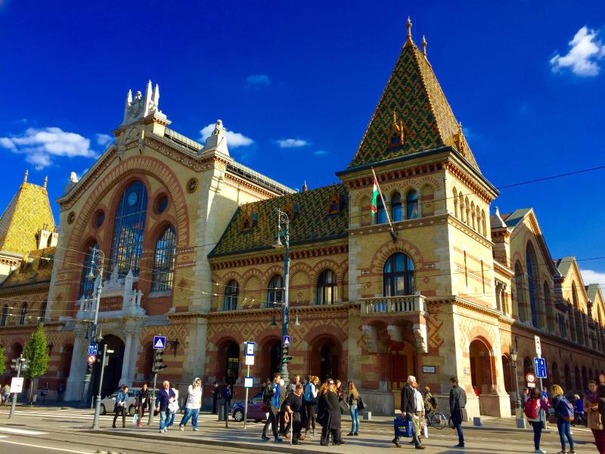
Photo: customtravelnetwork.com
The Great Market Hall, also known as the Central Market Hall or Nagycsarnok in Hungarian, is one of Budapest’s most iconic landmarks and a vibrant hub of culinary delights and cultural experiences. Situated at the Pest end of the Liberty Bridge, overlooking the Danube River, this majestic three-story building is a masterpiece of late 19th-century architecture.
Designed by renowned architect Samu Pecz in 1897, the Great Market Hall combines elements of Neo-Gothic and Art Nouveau styles, featuring a distinctive red-brick facade adorned with decorative motifs, ornate wrought ironwork, and soaring glass windows that flood the interior with natural light.
Inside, visitors are greeted by a bustling marketplace brimming with stalls selling a diverse array of fresh produce, meats, cheeses, spices, and other local delicacies. From paprika and pickles to pálinka and pastries, the market offers a tantalizing glimpse into Hungary’s culinary traditions and gastronomic heritage.
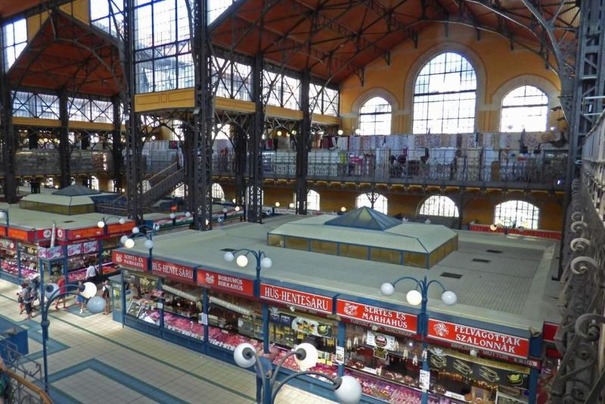
Photo: Klook.com – Interior of the Market Hall
5. Hungarian House of Music
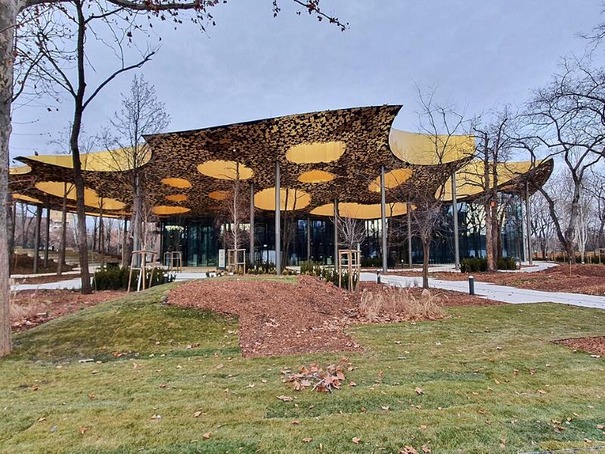
Photo: Wikipedia – The intriguing exterior of the Hungarian House of Music
The Magyar Zene Háza, or Hungarian House of Music, is housed in a striking architectural masterpiece located in the heart of Budapest. The building itself is a modern marvel, featuring sleek lines, contemporary design elements, and state-of-the-art facilities. Its facade reflects the dynamic and innovative spirit of Hungarian music, with a blend of traditional and avant-garde aesthetics.
As part of the Liget Budapest Project, the institution features permanent exhibitions highlighting both universal and Hungarian music history. The building was designed by Japanese star architect Sósuke Fujimoto, who envisioned a nature-inspired, translucent glass structure nestled among the trees of the park.
Inside, visitors are greeted by spacious galleries adorned with interactive exhibits, multimedia displays, and immersive audiovisual installations that showcase the rich history and diverse genres of Hungarian music.
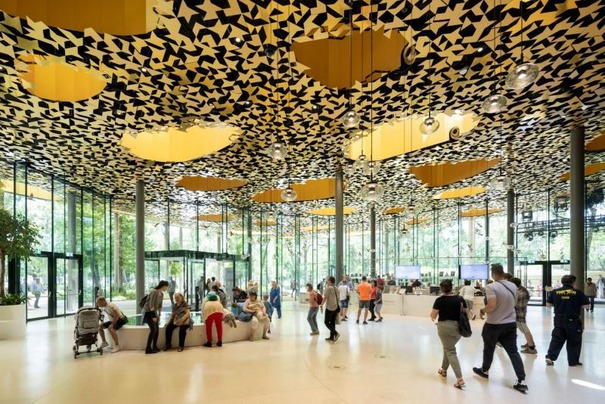
Photo: metalocus.es – The magnificent interior
6. Paris Courtyard Downtown
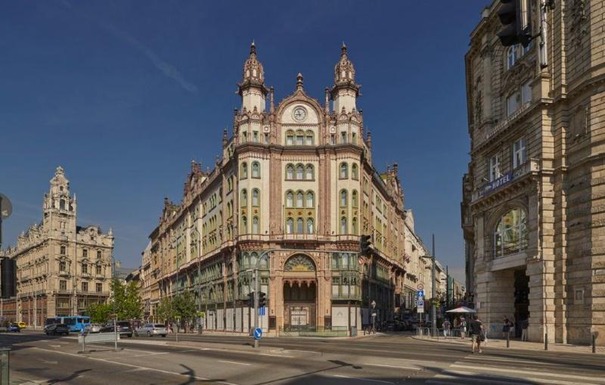
Photo: mellowmoodhotels.com
The Párizsi Udvar, or Paris Court, is a historic shopping arcade located in the heart of Budapest’s downtown district. Originally constructed in the early 20th century, the Párizsi Udvar was designed by architect Henrik Schmahl in a stunning blend of Art Nouveau and Neo-Gothic architectural styles. Its elegant facade, adorned with intricate sculptures, ornate detailing, and arched windows, evokes the grandeur of Parisian architecture.
For decades, the Párizsi Udvar served as a bustling commercial center, housing shops, cafes, and offices, and attracting visitors from near and far with its enchanting beauty and vibrant atmosphere. However, over time, the building fell into disrepair and underwent periods of neglect. In recent years, the Párizsi Udvar has undergone an extensive restoration and revitalization project aimed at preserving its historic charm while transforming it into a modern luxury destination. As part of this redevelopment effort, the building now houses a prestigious hotel, bringing new life to this iconic landmark.
The recently opened hotel within the Párizsi Udvar seamlessly blends contemporary elegance with historic charm, offering guests a luxurious and immersive experience in the heart of Budapest. With its meticulously restored facade, lavish interiors, and world-class amenities, the hotel pays homage to the building’s storied past while providing the utmost in comfort and sophistication for modern travelers.
7. Hungarian State Opera House
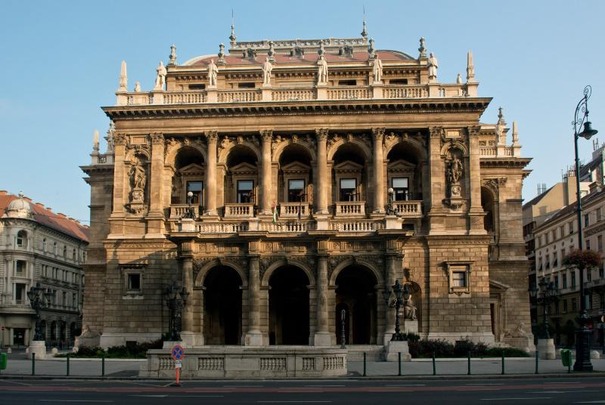
Photo: widest.com
The Budapest Opera House, also known as the Hungarian State Opera House or Magyar Állami Operaház in Hungarian, is a magnificent architectural gem and a cultural icon located in the heart of Budapest. Designed by renowned Hungarian architect Miklós Ybl, the opera house was inaugurated in 1884 and quickly established itself as one of Europe’s leading opera venues.
With its stunning Neo-Renaissance facade, grand staircase, and opulent interiors adorned with marble columns, gilded ornamentation, and intricate frescoes, the Budapest Opera House is a testament to the city’s rich artistic heritage and architectural splendor.
Beyond its architectural beauty, the opera house is renowned for its world-class performances and artistic excellence. Home to the Hungarian State Opera and the Hungarian National Ballet, the venue hosts a diverse repertoire of operas, ballets, concerts, and other cultural events throughout the year, showcasing the talents of both Hungarian and international artists.
In addition to its main stage productions, the Budapest Opera House also offers guided tours, educational programs, and special events that provide visitors with insight into the history, architecture, and inner workings of this historic institution.
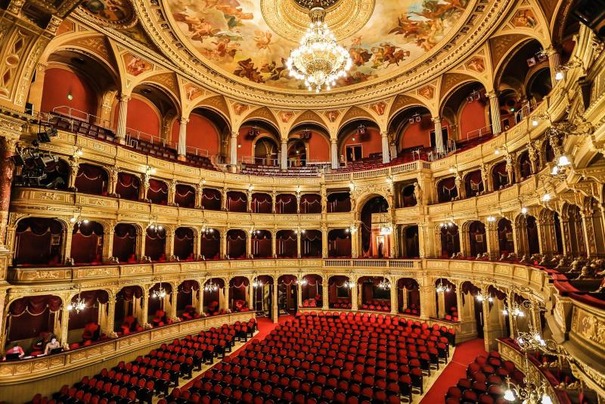
Photo: Magyarhirlap.hu
8. Dohány street Synagogue
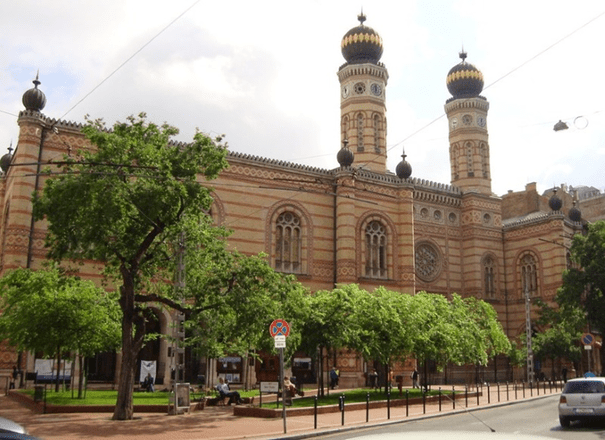
Photo: flickr.com
The Dohány utcai Zsinagóga is not only the largest synagogue in Europe but also one of Budapest’s most iconic landmarks.
The building and its surrounding got its name after the now defunct tabacco (dohány) factory dubbing it Dohány Street Synagogue.
Built in the mid-19th century in a unique Moorish Revival style, the synagogue boasts a striking facade adorned with intricate patterns and colourful ceramic tiles. Inside, visitors can explore the synagogue’s ornate interior, including its majestic ark, stunning stained-glass windows, and historic Jewish Museum. The building and its surroundings got its name after the now defunct tabacco (dohány) factory. As a symbol of Budapest’s rich Jewish heritage and a testament to the resilience of its community, the Dohány Street Synagogue holds a special place in the city’s cultural landscape.
Designed by architect Ludwig Förster and built in 1854 and 1859, the synagogue’s exterior is characterized by its grand facade adorned with intricate Islamic-inspired motifs, colorful ceramic tiles, and two soaring onion-domed towers. The interior features a breathtakingly ornate sanctuary with rows of elegant columns, elaborate arches, and a stunning ark housing the Torah scrolls.
In addition to its architectural splendor, the Dohány Street Synagogue holds deep historical significance as a symbol of Budapest’s vibrant Jewish community and its resilience in the face of adversity. It serves as a poignant memorial to the thousands of Hungarian Jews who perished during the Holocaust, with a moving Holocaust memorial garden located in its courtyard.
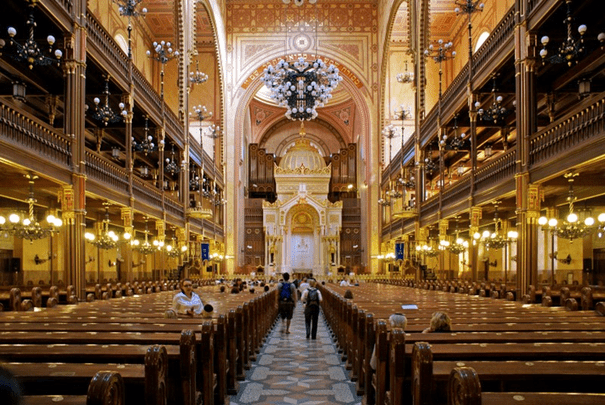
Photo: dohany-zsinagoga.hu
9. Museum of Applied Arts
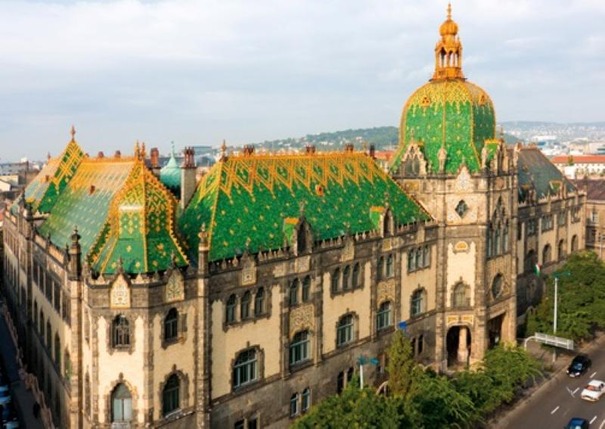
Photo: Blogspot.hu – The fascinating majolica rooftop of the Museum of Applied Arts
The Iparművészeti Múzeum, or Museum of Applied Arts, is a masterpiece of Hungarian Secessionist – Art Nouvo architecture and a must-visit destination for art and design enthusiasts. Designed by renowned architect Ödön Lechner and completed in 1896, the museum’s distinctive facade features vibrant Zsolnay ceramic tiles and intricate floral motifs inspired by Hungarian folk art. Inside, the museum’s collection spans various disciplines, including ceramics, glassware, textiles, furniture, and metalwork, showcasing the innovative craftsmanship and artistic expression of Hungarian artisans from the late 19th to the early 20th century.
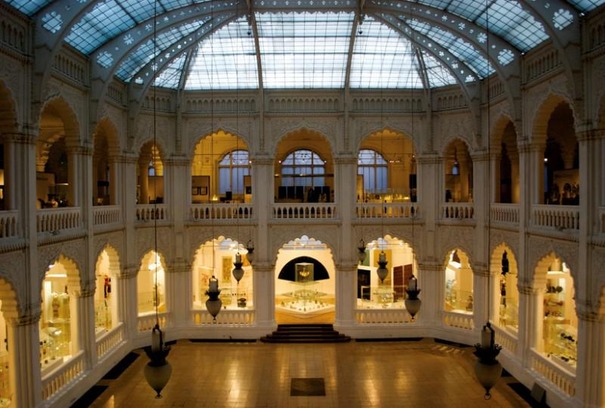
www.culturalheritageonline.com
10. Gresham Palace – Four Seasons Hotel
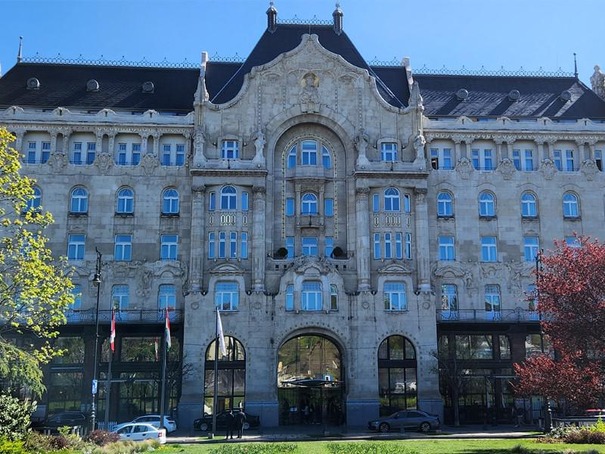
Photo: Silverline Cruises
Gresham Palace, located along the Danube River in Budapest’s Pest side, is a magnificent example of Art Nouveau architecture and one of the city’s most iconic landmarks. Originally built as a luxury apartment building in the early 20th century, the palace underwent a meticulous restoration in the early 2000s and now serves as a lavish Four Seasons Hotel. Its stunning facade features intricate detailing, including floral motifs, ornate ironwork, and sculptural elements, while its interior boasts elegant marble staircases, stained glass windows, and a breathtaking glass dome. With its blend of historic grandeur and modern luxury, Gresham Palace offers visitors a glimpse into Budapest’s rich architectural heritage and timeless elegance.
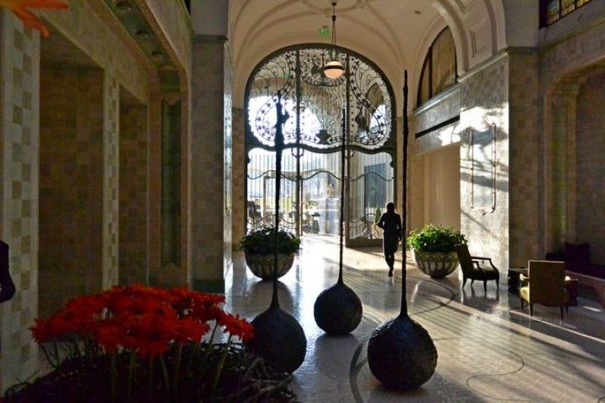
Photo: funiq.eu – Gresham interior
We hope you find some interesting buildings to discover in Budapest. We also would like to state that this is just the tip of the iceberg! Budapest is crammed with hundreds of stunning buildings. We also left out some of the more obvious sights such as the Parliament building or Matthias Church. So be on the lookout for more spectacular architecture within Budapest.
